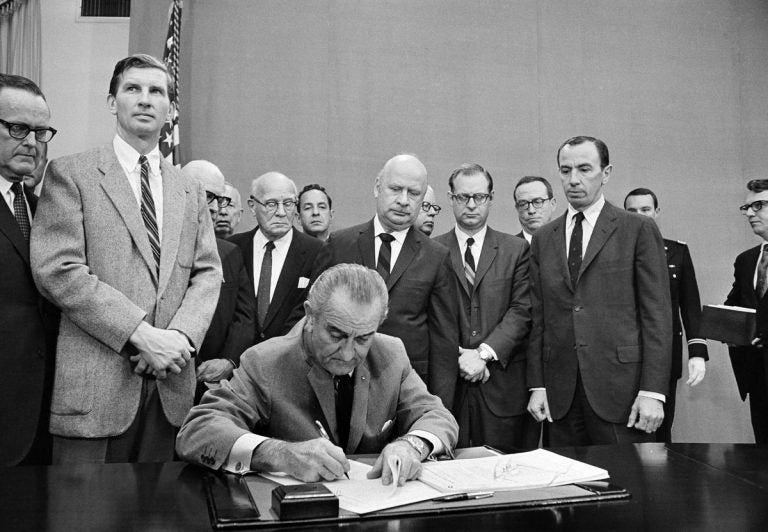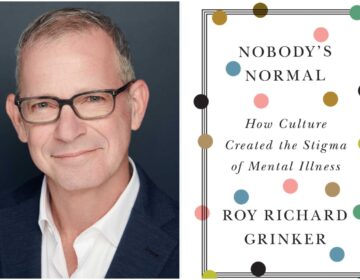Few violent episodes triggered by mental illness
So why do we still expect the mental health system to decide who’s dangerous?
Listen 8:31
President Lyndon B. Johnson signs a gun control bill at the White House, Oct. 22, 1968. (AP Photo)
For decades, policymakers have decided on gun laws assuming that mental illness contributes to gun violence. After every mass shooting, mental illness is quick to become the answer to the question everyone asks: How could someone have done such a thing?
They must have been mentally ill, is a convenient explanation.
But most research shows, in reality, very little violence is caused by mental illness. And if that’s the case, some psychologists believe that entrusting the mental health system with the job of predicting violence could be dangerous.
A few months ago, Dr. Amy Barnhorst got a new patient, an 18-year-old high school student who’d threatened to shoot up his school. As the medical director at the inpatient psychiatric hospital at UC Davis in California, Barnhorst sees this type of patient a lot for a psychiatric evaluation.
“His reasons for doing this were kind of unclear to me,” Barnhorst recalled. “But [they] didn’t seem delusionally based, or that he was acting out of paranoia. He just seemed like he didn’t really like the people he was at school with, and he was angry and bitter at them, and he didn’t really seem very remorseful.”
Barnhorst’s concluded the young man had serious potential for violence. But the standard for involuntary commitment in California — and many places — is that an individual must be deemed a danger due to a mental illness. So Barnhorst had to be sure that he was dangerous to himself or others because of a mental illness.
“And this is something that comes up with school shooters a lot,” she said. “Yeah, this guy was clearly at risk of violence. But was he mentally ill?”
And her answer was no, he was not.
She wouldn’t say he was well — he was antisocial, entitled and aggrieved — but those aren’t things an acute, inpatient psychiatric hospital addresses. They’re more like personality traits, better dealt with through years and years of therapy — which, by the way, an individual must agree to undergo. But even though she knew he was probably not mentally ill, Barnhorst was in a bit of Catch-22.
“If we do release him, then what? If this were a much lower-risk situation, I probably would have sent the person out and discharged them and said, ‘You don’t meet criteria,’ ” she said. “If you’re wrong about a school shooter, it’s really bad.”
In the end, she admitted him. But because he didn’t want to be there, he appealed his case, and it was up to a hearing officer to consider the same information Barnhorst had in deciding whether he posed a threat because of a mental illness.
“And in this case, the hearing officer says, ‘I don’t believe he does,’ ” said Barnhorst.
They let him go.
Barnhorst said her team was in touch with law enforcement, who continued monitoring his behavior after his release. They also recommended outpatient therapy for him, but he would have to willingly show up for it.
Quest for quick answers
Research indicates that only about 4 percent of violence in the U.S. is caused by mental illness. With mass shootings, it is possible the number is higher. Because so many mass shooters kill themselves, making psychiatric evaluation impossible, it’s very hard to tell. Even so, media and politicians are quick to question the mental health systems and professionals surrounding an individual who has committed a violent act.
“Particularly in the aftermath of mass shootings, we always want to know, why didn’t the mental health system catch this?” said Beth McGinty who researches policy at the intersection of mental health and violence at Johns Hopkins. “We think like, ‘What in the world, how did they miss this?’ ”
But, if mental illness isn’t causing violence, perhaps nothing was missed. The mental health system should not be in the business of figuring out who’s going to be dangerous, McGinty said.
“The research evidence just very clearly shows that psychiatrists are not very good at predicting violence, and it’s not because they’re not doing their job. It’s because violence is very rare overall among people with mental illness,” she said.
That’s not to say violence is never triggered by mental illness. And when it is, it gets a lot of attention. Several high-profile examples stick out.
After U.S. Rep. Gabrielle Giffords was shot in Tucson in 2011, gunman Jared Loughner was diagnosed with schizophrenia — psychologists said his delusions were causing him to feel threatened and act violently. The gunmen in the Aurora, Colorado, movie theater, and the Virginia Tech shooting both suffered mental illness.
The research also shows it’s necessary to keep guns away from those who are dangerous because of mental illness — the threshold Barnhorst was testing for with her patient at the psychiatric hospital in Davis.
That doesn’t mean we should think of everyone with mental illness as potentially dangerous, McGinty stressed.
“Linking mental illness with violence, that increases public perceptions of the dangerousness of this population,” she said. “And that stigma leads to discriminatory behaviors — people don’t want to hire someone with mental illness, they don’t want to have someone with mental illness marry into their family, that sort of thing”
Still, McGinty said, she understands the inclination. We’re eager for an explanation, and mental illness gives us one.
“We want to be able to say, ‘This is what the cause was, and here are some solutions to address that cause.’ When there is another clearly identified cause, extremism for example, we don’t jump to this mental illness narrative,” she said.
When violence is related to terrorism or hate crimes or domestic disputes, we’re not so quick to blame mental illness. But we’re still eager for a simple answer, according to McGinty.
“Often the reality is that the causes of violent behavior are very complex — you can’t nail down one specific thing. And that is not very satisfying, right?”
Other indicators of violence
Back at the psychiatric hospital in California, Barnhorst operates in a unique gap between the criminal justice and mental health systems, where she is expected to care for people who haven’t committed any crimes, don’t have a treatable mental illness, but are at risk of becoming dangerous.
She wants to keep everyone safe, but she doesn’t think admitting people she knows aren’t mentally ill is the way. Doing so has consequences, Barnhorst said.
“I’m filling my 50-bed inpatient hospital with people that I’m not really able to treat. I’m making those beds unavailable for people who are actually really mentally ill and need to be here,” she said.
On top of that, she worries that using a psychiatric hospital to warehouse people who aren’t mentally ill may be sending a larger message: “Yeah, send all those people over to me. I’ll just put them on the inpatient unit and have them hang out there until they settle down or something changes. I’m not sure what.”
Mental illness may not be the best way to predict whether someone will be violent, but there are indicators that work better, that some states are trying out instead.
Based on the evidence, the best indicator of violence is a history of violence. Federally, if you’ve committed a felony, you are prohibited from purchasing a gun, but some states are extending that logic to violent misdemeanors, too. In most places, those convicted of domestic violence are not allowed to own guns.
Alcoholism is also highly correlated with violence. And while that may be harder to measure, some states are doing so using DUI’s. For example, in Pennsylvania, anyone with three DUIs in a five-year period cannot own a gun.
Still, in those scenarios, something bad has already happened: a violent crime or drunken driving. That’s why some states are trying to head violence off at the pass by implementing “gun violence restraining orders.”
Modeled closely after domestic violence restraining orders, the gun violence restraining orders (sometimes called “extreme risk protection orders”) allow a family member or law enforcement officer who believes an individual could pose a danger to petition a judge to take away a weapon. The judge simply evaluates the risk in ordering that weapons be confiscated.
These laws are on the books in California, Washington and Oregon. Florida passed similar legislation in the wake of the Parkland shooting.
“It could be that someone is experiencing a psychotic episode for the first time and behaving in a way that is erratic or threatening,” said McGinty. “It could be that someone lost their job and is drinking a lot of alcohol and is behaving in a way that is violent, punching walls.”
“It could be that someone is making the sort of general threats that wouldn’t be enough for involuntary commitment,” she added.
But those threats might be enough to take away someone’s guns.
WHYY is your source for fact-based, in-depth journalism and information. As a nonprofit organization, we rely on financial support from readers like you. Please give today.







